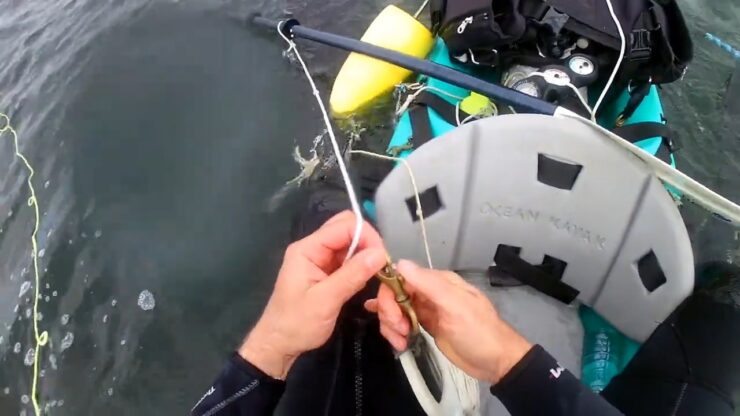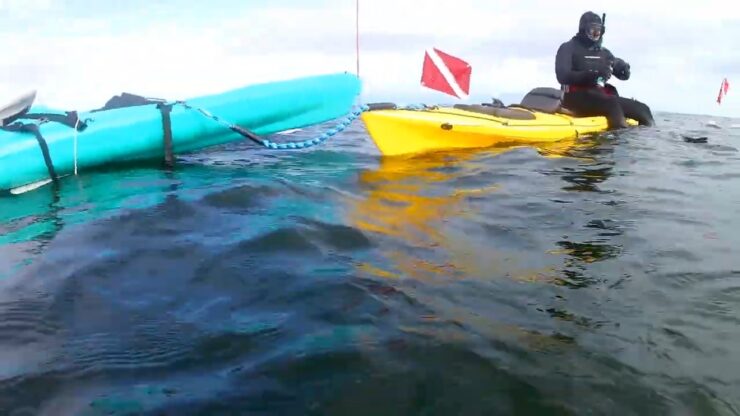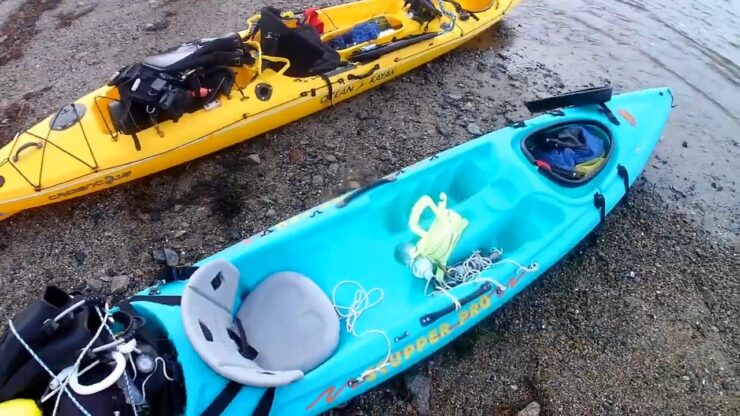I still dive some, even at my age, although now it is mostly snorkeling and in freshwater. In days gone by, I have seen diving evolve tremendously from my early days of the twin hose open circuit regulators.
Equipment is now much safer, more efficient, and more reasonably priced. It’s a great time to take up diving.
Diving in freshwater has never been much of a problem, but diving from the coast has always had its problems, well just one, really. That is the surf. The waves could knock you off your fins while entering, knock-off equipment, and more. Back in the day, you only had a few options:
- Wade backward (with fins on, no less…) into the waves until you get past the surf line, or deep enough to submerge. It’s hard enough to walk in fins without having to do it in reverse, and not see where you are going. I was always worried about getting run over by a surfer or smacked by a large piece of driftwood. I’ve been hit by lots of jellyfish, and other unpleasant stuff that rides the waves sometimes.
- Use an inflatable Zodiac-type boat. Waves can bounce you and your equipment into the soup, and flips are not uncommon. A motor is a necessity, when it works because inflatable rafts move like a pregnant manatee.
- Charter a boat to take you out …expensive.
Another drawback was that your actual diving area is going to be some distance offshore, most of the time, so you have to waste precious air just getting to and from the site. Anything more than a few hundred yards offshore was not really feasible.
Enter the modern Sit On Top Kayak (SOT). Normally, I am not a big fan of SOTs, but for diving, there is nothing better. They may not paddle as fast as a Sit Inside Kayak (SIK), but they are plenty fast enough for fishing and diving.
They are pretty much unsinkable, very stable, and have plenty of room for your gear.
Sure, you may get wetter in one, but your intention was to get wet, anyway, right? It is amazing how big a wave a SOT can slice through when you hit it head-on. Entry and Exit from the water is also relatively easy. You can easily paddle a SOT for miles and miles, and I have never had a paddle fail to start or run out of fuel.
Table of Contents
Toggle1. Getting Loaded: Managing Your Diving Equipment on The Kayak
Diving from a yak takes a little planning and consideration. You need to figure out what you will need first. Remember, the first things you load will be on the bottom, so you want them to be the last things you need. Make sure everything, and I mean everything is tied down or tethered to the yak, even things that are going into the hatches. It makes it easier to get them out if they shift to the bow.
Make sure anything that needs to be assembled, is assembled, like tanks, regulators, BC, etc… The really cool thing about SOTs is that they have a molded cargo well in the stern that makes a perfect tank well. Just use an adjustable strap to tie down the tanks, then partially inflate the BC to snug everything up.
You’ll be wearing your wetsuit or drysuit, but you can take off the top of a wetsuit or roll it down to make it easier to paddle until you get where you are going. Knights of the Drysuit … you’re stuck with wearing it until you get into the water.
Drag your yak to the edge and watch the waves to get the right timing.
Just like surfing, timing is everything. There will be a big wave, followed by a few smaller ones. When the big wave hits, drag your yak to waist-deep water, mount, and paddle like crazy. Keep the bow pointed directly into the waves, and keep paddling until you get through the surf. If you flip, just hang on until the next series of waves, do a wet entry and retry.
2. Getting Wet: Starting The Dive

When you reach the dive point, ship your paddle, making sure it is in a secure holder or well-tethered. Put up your Diver Down flag. Put on your fins first and hang your legs over each side.
Fins provide incredible stability, almost like outriggers. After you don the mask, knife, etc…, there are a few ways to get into your SCUBA gear. You can stand it on end, lean forward and butterfly yourself into the harness.
Or, I just grab the tank and roll over the side. I put it on in the water. If there is nothing to tie the yak to, you can just take your anchor down with you and place it in a good spot.
3. Coming Aboard Afterwards

Getting back aboard is pretty much just a reverse of getting wet. Remove your SCUBA and put it in the well, tie it back down, and remove the rest of your gear. Leave your fins on.
Store everything where it belongs if you can reach it, otherwise place them in secure places until you get back aboard. To board, kick your feet to get them to the surface.
Hold yourself at arm’s length, perpendicular to amidships, and give a good strong kick or two, while pulling yourself up and over onto your belly across the yak. Now, just roll over and pivot into the seat. Remove your fins, finish securing your gear, grab the paddle and head back to the beach.
4. Landing: Getting Back Ashore Safely

As you approach the surf line, watch the waves for the right timing. When a large wave comes by. Tuck in right behind the crest and paddle to match the wave’s speed.
Stay right behind the crest and ride it all the way to the beach. As soon as you ground, hop off and grab the yak so that the next wave does not suck you back out. Drag your yak onto dry sand, and you’re in.
This was a very simplistic article on the subject, and much more detailed information is available online. I highly recommend exploring the information as much as possible.
Using a kayak as a dive platform is one way to really get to enjoy the sport without having to take out a second mortgage.
Adelaide Gentry, a seasoned kayaking enthusiast and expert, is the driving force behind KayakPaddling.net. With over a decade of experience navigating the world’s most challenging waterways, Adelaide combines her passion for adventure with a deep knowledge of kayaking to provide insightful and practical guidance for paddlers of all levels.
Related Posts:
- Heavy Duty Fishing: 11 Best Rods And Reels For Big Fish 2024
- 15 Best Baitcasting Reel Under $100 2024 - Improve…
- 16 Best Kayak For Beginners 2024 - Kayaking Adventure Gear
- Snorkeling for Kids: Safety, Fun and Kid-Friendly…
- 17 Best Trolling Reels 2024 - Enjoy your Fishing Adventure
- 10 Best Inflatable Paddle Board 2024: My Top 10 iSUP…












